A huge mountain-sized space phenomenon known as the Devil Comet will be prime for spotting this weekend as it reaches its maximum brightness in a one-in-70-year event.
Officially known as Comet 12P/Pons-Brooks, horn-shaped explosions of ice and gas were spotted on its 10.5-mile-wide surface last year, giving rise to its fiendish nickname.
On April 21, the comet will reach perihelion, the name for the closest point to our star, when it will appear brightest in our skies, about 144 million miles from the sun.
It will appear close to the west-north-west horizon in the Northern Hemisphere, and will be best visible right after sunset with a telescope or binoculars.
But, according to NASA, spotting the comet will be challenging unless there is a completely clear view of the horizon an hour post-sunset. Approximately a few hours after the sun sets, the comet will no longer be visible.

12P/Pons-Brooks is a periodic comet that makes an orbit around the sun approximately every 70 years. It was first identified by Jean-Louis Pons in July 1812 and later by William Robert Brooks in 1883, so it was named after both discoverers.
Its most recent close pass to the sun occurred in 1954, and it is not expected to come this close again until 2095. But the predictions can't be totally exact.
"The solar system is a bit of a chaotic place, asteroids, comets, and their associated dust and debris, are continually being nudged around by the gravity of the planets, changing the paths they follow through space," Jonti Horner, an astrophysics professor at the University of Southern Queensland, Australia, told Newsweek.
The comet's aphelion—its greatest distance from the Sun—is situated slightly farther than Neptune's orbit, while at perihelion, it skims past the sun just further away from the star than Venus's orbit.
The comet has gotten brighter and brighter as it nears the sun, and is thought to potentially reach a magnitude of 4.5 by April 21. Brightness in astronomy is measured by magnitude, where a lower or more negative value indicates greater brightness: for instance, the full moon shines at -13, and the sun at -27.
Prominent stars like Sirius and Antares display magnitudes of -1 and +1, respectively. Generally, objects with a magnitude of +6 or less are visible to the naked eye.
As the comet has approached, it has moved across our skies, having moved through the constellations of Pisces and Aries, and is currently entering Taurus.
While the comet will get dimmer as it moves away from the sun, it will actually reach its closest point to Earth on June 2, passing us at a distance of about 144 million miles, roughly 1.5 times the distance between the Earth and the sun.
"Pons-Brooks is also known to exhibit erratic outbursts (confirmed by recent observations) so this gives astronomers more excitement in observing it," Quanzhi Ye, an astronomer at the University of Maryland who studies the comet, previously told Newsweek.
This comet has been regularly spotted via telescope undergoing explosively outbursts, spewing out dust and gases. One of these cryovolcanic outbursts in July last year resulted in two trails of gas and dust streaming out behind the rock, giving the appearance of two horns.
Do you have a tip on a science story that Newsweek should be covering? Do you have a question about comets? Let us know via science@newsweek.com.
Uncommon Knowledge
Newsweek is committed to challenging conventional wisdom and finding connections in the search for common ground.
Newsweek is committed to challenging conventional wisdom and finding connections in the search for common ground.
About the writer
Jess Thomson is a Newsweek Science Reporter based in London UK. Her focus is reporting on science, technology and healthcare. ... Read more
To read how Newsweek uses AI as a newsroom tool, Click here.








